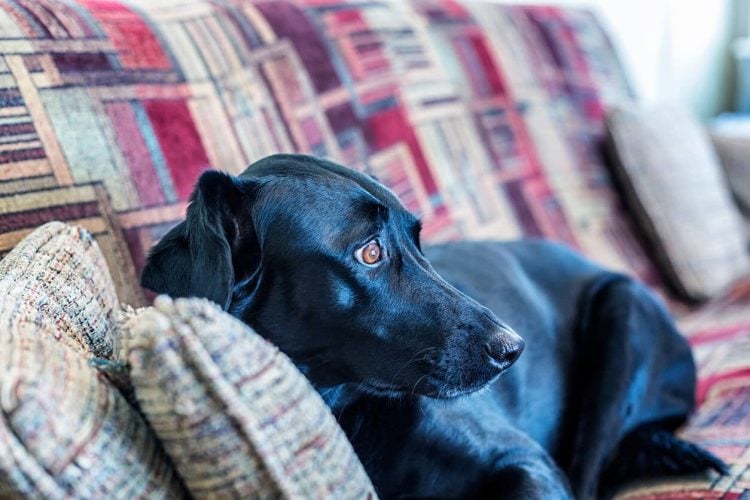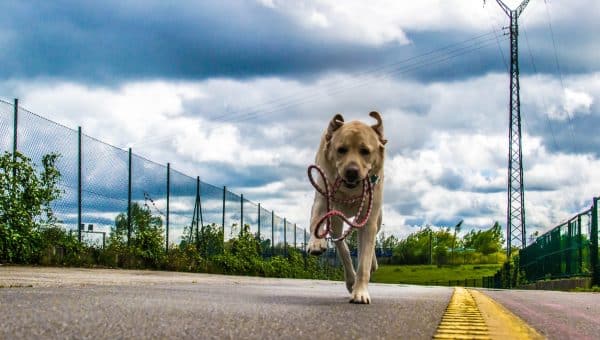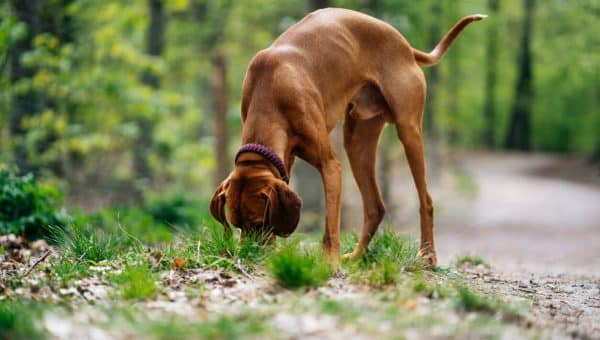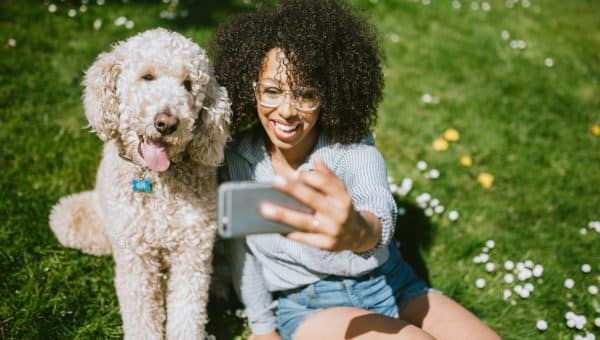- Not a substitute for professional veterinary help.
Like humans, dogs can experience anxiety—but they can’t talk about those feelings or share the source of the distress. This, of course, makes it tough for loving pet parents to help with dog anxiety!
Dog anxiety can be a complex concern, and it’s not necessarily the same type of anxiety that humans experience. Generally, it doesn’t happen on its own, which means your dog’s nervous and fearful behaviors have some underlying cause.
Anxiety that goes unaddressed can have a major emotional and physical impact for both you and your dog, according to Dr. Meaghan Thomas, DVM and certified veterinary acupuncturist at East Ridge Animal Hospital.
In fact, many pet parents who don’t know how to handle the anxiety or help their dog consider rehoming their only option. Yet there’s actually a lot you can do to care for a dog with anxiety and help them feel more secure—and it begins with pinpointing the cause.
Read on to learn the signs and possible causes of anxiety in dogs, plus get a few tips for handling it safely and effectively.
Top Signs Of Dog Anxiety, From Body Language To Behavior
Recognizing signs of stress and anxiety in your dog can help you provide appropriate care and support, not to mention keep them safe.
“Dogs with anxiety may display destructive behaviors in an effort to cope with the anxiety,” Dr. Thomas says, adding that they can also injure themselves or ingest toxic or obstructive objects.
Some common signs and behaviors you might notice in a dog with anxiety include:
- Tail tucking
- Teeth baring, which can resemble a forced smile
- Shaking and shivering
- A hunched or tightly curled body
- Licking air, which may seem like tongue flicking or nose licking
- Yawning, panting, or drooling
- Sweaty paws
- Frequent whining, howling, and other vocalizations
- Hiding or backing into a corner
- Drooped or flattened ears
- “Whale eye,” which happens when they show the whites of their eyes
Dog anxiety can also show up in the following ways:
Noise sensitivity
Does your dog hide or run away from loud noises? Plenty of dogs dislike noisy events like storms, nearby construction, and fireworks. But some dogs may also seem very nervous or fearful around everyday noises, like coffee grinders, vacuum cleaners, or a noisy washing machine—and their fear may persist after the sound stops.
Your dog may hide, bark, shake, or shiver. You might also notice them curling up or tucking their tail in tightly under their stomach.
Fear of surfaces and heights
You might not necessarily consider it a bad thing if your dog seems afraid of jumping onto the furniture. Even so, a fear of heights or certain surfaces can affect your dog’s quality of life if it limits their ability to enjoy walks or playtime with you!
Some dogs may also seem reluctant to enter specific rooms or walking on certain types of surfaces.
Difficulty paying attention
Inattention isn’t the same thing as anxiety, but they can show up together.
You might notice your dog seems very distracted, even at important times like playtime and mealtime. Or maybe they restlessly move from spot to spot, can’t sit still, and have trouble focusing during training sessions or when you’re out for a walk.
Compulsive behaviors
Dog anxiety will sometimes show up as repetitive behaviors that have no specific purpose. Examples include:
- Pacing or running in circles
- Tail chasing
- Licking or chewing
- Destroying or eating toys or household objects
Separation anxiety
If you’re at home, your dog may stick close to your side and follow you from room to room. When you get home after work or an errand, your dog may seem frantic and overjoyed that you actually came back.
While you’re out of the house, a dog with separation anxiety may also:
- Destroy household items
- Whine, howl, or bark
- Pee and poop indoors
- Do themselves injury, often by chewing on their paws or tail
Resource guarding
Some dogs with anxiety are very protective of their food, treats, and toys. They may growl, bark, or become aggressive toward you and other pets who approach the treasured item.
In some cases, your dog may also begin to guard a favorite person, their territory, or a specific place in your home, like an extra-cozy napping spot. It may go without saying, but this behavior can become dangerous if your dog actually bites or lunges at you or another person or pet.
Aggressive behavior
Signs of aggression can include:
- Growling and snarling, typically with curled lips
- A stiff body
- Lunging
- Teeth baring
- Snapping and biting
Important: Aggression in dogs often stems from fear, especially when it shows up suddenly. Punishment won’t help—but finding and addressing the cause can make a huge difference.
What Causes Dog Anxiety?
Again, dog anxiety often doesn’t have one single specific cause. It also doesn’t affect every dog in the same way.
“High energy and working breeds tend to manifest anxiety more frequently,” Dr. Thomas says. She adds that dogs can also develop anxiety at different ages, depending on what causes the anxiety. Young, active dogs may develop anxiety, but it can also show up first in the senior years due to age-related cognitive dysfunction.
Research suggests some possible contributing factors, including:
- Genetics, or traits inherited from their parents
- Early experiences, like isolation or punishment
- Trauma, like abandonment, separation from a pet parent, or repeated rehomings
- Lack of socialization
- Medical conditions like cognitive dysfunction syndrome, which often affects senior dogs
A few specific things that may trigger dog anxiety include:
- Changes to a regular routine, like suddenly having to spend more time home alone
- A new addition to your family
- Moving to a new house or unfamiliar environment
- Long car rides
- Visits to the veterinarian or groomer
Tips To Calm An Anxious Dog
When it comes to easing your dog’s anxiety, you have a lot of options—but working with a professional is a great first start, Dr. Thomas emphasizes.
If your dog is in good health, you can work with a dog behaviorist to identify possible anxiety triggers and explore solutions to help your dog feel more comfortable.
Trained behaviorists can offer support with a specific behavior modification plan to help soothe your dog’s anxiety long-term.
As you work to address the underlying source of the anxiety, these five strategies can help your dog feel supported and secure during an anxious episode:
- Stay calm: When your dog shows signs of anxiety, it’s important to speak softly to reassure them that they’re safe and you aren’t angry with them. Trying to scold or punish your dog for anxious behaviors, like pacing, whining, or digging, will only make them worse.
- Follow a routine: Knowing what to expect from each day may automatically help your dog feel less anxious. Try to keep the same schedule for meals, walks, playtime, and “quiet time” in their crate. Even small routines, like having your dog sit every time before you go outside or give them dinner, could make a difference in their anxiety—this helps them learn what happens after each behavior.
- Create a safe space: Setting up a quiet and comfortable room in your home will give your dog somewhere to go when something scary or stressful happens. If you don’t have a full room, you can create a cozy space in a closet, your bedroom, or in their crate. Make sure to add plenty of your dog’s favorite blankets and bedding, toys, and familiar objects and scents (like one of your T-shirts!).
- Try natural remedies: ThunderShirts, dog appeasing pheromones, and calming treats may all help soothe some of your dog’s nervousness and distress. These methods don’t work for every dog, but many dogs with anxiety do get some relief.
- Get your dog used to your departure: If your dog has separation anxiety, behavior modification and training will involve gradually helping them adjust to you leaving. This will take some time and patience, but it’s possible!
Just keep in mind that all dogs are unique. The best type of anxiety relief for one dog may not work for another dog.
Paying close attention to your pup’s body language and behaviors can help you recognize when one method works and when it may be best to try another approach.
Remember, each dog is unique, and what works for one may not work for another. Your vet can always offer more guidance, especially when your dog seems very distressed.
When To Get Help From Your Vet
Home remedies and training can go a long way toward soothing anxiety for many dogs. In some cases, though, prescription treatment may be a necessary step in treating your dog’s anxiety, Dr. Thomas says.
If your dog’s anxiety persists or gets worse, you’ll want to seek support from your vet as soon as possible. They can examine your dog and help rule out underlying medical causes of anxious and fearful behaviors. When home remedies and training haven’t done much to relieve your dog’s anxiety, a vet can also prescribe anti-anxiety medications.
Important: Never give a dog human medications for anxiety. If you give your dog CBD for anxiety, always make sure the product is labeled for use in dogs and check the dose with your vet.
With patient care and a holistic approach, you can create a nurturing environment for your anxious dog and help them feel safe, secure, and loved. This will go a long way toward not just easing their anxiety, but also strengthening your bond!







